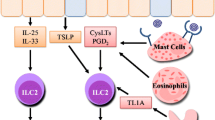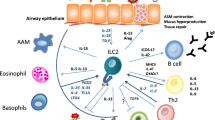Abstract
Allergic airway inflammation develops in the context of innate immune cells that express Toll-like receptors (TLRs). TLRs recognize microbial components and evoke diverse responses in immune and other respiratory cells through distinct signaling pathways. Bacterial and viral infection in the airway modulates the extent of allergic inflammation. TLR stimulation controls T helper (Th) 1, Th2, and Th17 cell differentiation, cytokine production in mast cells, and activation of eosinophils via direct and indirect pathways. TLR signals in dendritic cells increase expression of major histocompatibility complex proteins and T-cell coreceptors, resulting in greater T-cell activation with Th1 bias. TLR signals in mast cells increase their release of IL-5, and TLR signals in airway epithelial cells enhance airway generation of proallergic cytokines. Although these responses play an important protective role in infection, they may exacerbate allergic inflammation. Under some conditions, TLR stimulation, especially via TLR9, reduces Th2-dependent allergic inflammation through induction of Th1 responses. Therefore, understanding the regulatory role of TLRs in the pathogenesis of allergic airway inflammation may shed light on improving inflammation control in asthmatic patients.
Similar content being viewed by others
References and Recommended Reading
Chaudhuri N, Dower SK, Whyte MK, et al.: Toll-like receptors and chronic lung disease. Clin Sci (Lond) 2005, 109:125–133.
Takeda K, Akira S: Toll-like receptors in innate immunity. Int Immunol 2005, 17:1–14.
Trinchieri G, Sher A: Cooperation of Toll-like receptor signals in innate immune defence. Nat Rev Immunol 2007, 7:179–190.
Marks GB: Environmental factors and gene-environment interactions in the aetiology of asthma. Clin Exp Pharmacol Physiol 2006, 33:285–289.
Schroder NW, Maurer M: The role of innate immunity in asthma: leads and lessons from mouse models. Allergy 2007, 62:579–590.
Eder W, Klimecki W, Yu L, et al.: Toll-like receptor 2 as a major gene for asthma in children of European farmers. J Allergy Clin Immunol 2004, 113:482–488.
Cockcroft DW, Davis BE: Mechanisms of airway hyperresponsiveness. J Allergy Clin Immunol 2006, 118:551–559; quiz 560–551.
Umetsu DT, DeKruyff RH: The regulation of allergy and asthma. Immunol Rev 2006, 212:238–255.
Voynow JA, Gendler SJ, Rose MC: Regulation of mucin genes in chronic inflammatory airway diseases. Am J Respir Cell Mol Biol 2006, 34:661–665.
Monick MM, Powers LS, Hassan I, et al.: Respiratory syncytial virus synergizes with Th2 cytokines to induce optimal levels of TARC/CCL17. J Immunol 2007, 179:1648–1658.
Elsner J, Escher SE, Forssmann U: Chemokine receptor antagonists: a novel therapeutic approach in allergic diseases. Allergy 2004, 59:1243–1258.
Rothenberg ME, Hogan SP: The eosinophil. Annu Rev Immunol 2006, 24:147–174.
Hiscott J: Triggering the innate antiviral response through IRF-3 activation. J Biol Chem 2007, 282:15325–15329.
Solis M, Goubau D, Romieu-Mourez R, et al.: Distinct functions of IRF-3 and IRF-7 in IFN-α gene regulation and control of anti-tumor activity in primary macrophages. Biochem Pharmacol 2006, 72:1469–1476.
Sen GC, Sarkar SN: Transcriptional signaling by double-stranded RNA: role of TLR3. Cytokine Growth Factor Rev 2005, 16:1–14.
Iwasaki A, Medzhitov R: Toll-like receptor control of the adaptive immune responses. Nat Immunol 2004, 5:987–995.
Schnare M, Barton GM, Holt AC, et al.: Toll-like receptors control activation of adaptive immune responses. Nat Immunol 2001, 2:947–950.
Hollingsworth JW, Whitehead GS, Lin KL, et al.: TLR4 signaling attenuates ongoing allergic inflammation. J Immunol 2006, 176:5856–5862.
Kanzler H, Barrat FJ, Hessel EM, et al.: Therapeutic targeting of innate immunity with Toll-like receptor agonists and antagonists. Nat Med 2007, 13:552–559.
Revets H, Pynaert G, Grooten J, et al.: Lipoprotein I, a TLR2/4 ligand modulates Th2-driven allergic immune responses. J Immunol 2005, 174:1097–1103.
Sel S, Wegmann M, Sel S, et al.: Immunomodulatory effects of viral TLR ligands on experimental asthma depend on the additive effects of IL-12 and IL-10. J Immunol 2007, 178:7805–7813.
Redecke V, Hacker H, Datta SK, et al.: Cutting edge: activation of Toll-like receptor 2 induces a Th2 immune response and promotes experimental asthma. J Immunol 2004, 172:2739–2743.
Eisenbarth SC, Piggott DA, Huleatt JW, et al.: Lipopolysaccharide-enhanced, toll-like receptor 4-dependent T helper cell type 2 responses to inhaled antigen. J Exp Med 2002, 196:1645–1651.
Kim YK, Oh SY, Jeon SG, et al.: Airway exposure levels of lipopolysaccharide determine type 1 versus type 2 experimental asthma. J Immunol 2007, 178:5375–5382.
Bauer S, Hangel D, Yu P: Immunobiology of toll-like receptors in allergic disease. Immunobiology 2007, 212:521–533.
Duez C, Gosset P, Tonnel AB: Dendritic cells and toll-like receptors in allergy and asthma. Eur J Dermatol 2006, 16:12–16.
Harrington LE, Hatton RD, Mangan PR, et al.: Interleukin 17-producing CD4+ effector T cells develop via a lineage distinct from the T helper type 1 and 2 lineages. Nat Immunol 2005, 6:1123–1132.
Infante-Duarte C, Horton HF, Byrne MC, et al.: Microbial lipopeptides induce the production of IL-17 in Th cells. J Immunol 2000, 165:6107–6115.
Park H, Li Z, Yang XO, et al.: A distinct lineage of CD4 T cells regulates tissue inflammation by producing interleukin 17. Nat Immunol 2005, 6:1133–1141.
Bettelli E, Carrier Y, Gao W, et al.: Reciprocal developmental pathways for the generation of pathogenic effector TH17 and regulatory T cells. Nature 2006, 441:235–238.
Mangan PR, Harrington LE, O’Quinn DB, et al.: Transforming growth factor-beta induces development of the Th17 lineage. Nature 2006, 441:231–234.
Ivanov, II, McKenzie BS, Zhou L, et al.: The orphan nuclear receptor ROR γt directs the differentiation program of proinflammatory IL-17+ T helper cells. Cell 2006, 126:1121–1133.
Veldhoen M, Hocking RJ, Atkins CJ, et al.: TGFβ in the context of an inflammatory cytokine milieu supports de novo differentiation of IL-17-producing T cells. Immunity 2006, 24:179–189.
Weaver CT, Harrington LE, Mangan PR, et al.: Th17: an effector CD4 T cell lineage with regulatory T cell ties. Immunity 2006, 24:677–688.
Bullens DM, Truyen E, Coteur L, et al.: IL-17 mRNA in sputum of asthmatic patients: linking T cell driven inflammation and granulocytic influx? Respir Res 2006, 7:135.
Schnyder-Candrian S, Togbe D, Couillin I, et al.: Interleukin-17 is a negative regulator of established allergic asthma. J Exp Med 2006, 203:2715–2725.
Drazen JM, Arm JP, Austen KF: Sorting out the cytokines of asthma. J Exp Med 1996, 183:1–5.
Galli SJ, Nakae S, Tsai M: Mast cells in the development of adaptive immune responses. Nat Immunol 2005, 6:135–142.
Kulka M, Alexopoulou L, Flavell RA, et al.: Activation of mast cells by double-stranded RNA: evidence for activation through Toll-like receptor 3. J Allergy Clin Immunol 2004, 114:174–182.
Nigo YI, Yamashita M, Hirahara K, et al.: Regulation of allergic airway inflammation through Toll-like receptor 4-mediated modification of mast cell function. Proc Natl Acad Sci U S A 2006, 103:2286–2291.
Qiao H, Andrade MV, Lisboa FA, et al.: FcɛR1 and toll-like receptors mediate synergistic signals to markedly augment production of inflammatory cytokines in murine mast cells. Blood 2006, 107:610–618.
Matsushima H, Yamada N, Matsue H, et al.: TLR3-, TLR7-, and TLR9-mediated production of proinflammatory cytokines and chemokines from murine connective tissue type skin-derived mast cells but not from bone marrow-derived mast cells. J Immunol 2004, 173:531–541.
Homma T, Kato A, Hashimoto N, et al.: Corticosteroid and cytokines synergistically enhance toll-like receptor 2 expression in respiratory epithelial cells. Am J Respir Cell Mol Biol 2004, 31:463–469.
Sha Q, Truong-Tran AQ, Plitt JR, et al.: Activation of airway epithelial cells by toll-like receptor agonists. Am J Respir Cell Mol Biol 2004, 31:358–364.
Proud D, Chow CW: Role of viral infections in asthma and chronic obstructive pulmonary disease. Am J Respir Cell Mol Biol 2006, 35:513–518.
Matsukura S, Kokubu F, Kurokawa M, et al.: Synthetic double-stranded RNA induces multiple genes related to inflammation through Toll-like receptor 3 depending on NF-B and/or IRF-3 in airway epithelial cells. Clin Exp Allergy 2006, 36:1049–1062.
Liu YJ: Thymic stromal lymphopoietin: master switch for allergic inflammation. J Exp Med 2006, 203:269–273.
Ziegler SF, Liu YJ: Thymic stromal lymphopoietin in normal and pathogenic T cell development and function. Nat Immunol 2006, 7:709–714.
Kato A, Favoreto S Jr, Avila PC, et al.: TLR3-and Th2 cytokine-dependent production of thymic stromal lymphopoietin in human airway epithelial cells. J Immunol 2007, 179:1080–1087.
Wong CK, Cheung PF, Ip WK, et al.: Intracellular signaling mechanisms regulating toll-like receptor-mediated activation of eosinophils. Am J Respir Cell Mol Biol 2007, 37:85–96.
Didierlaurent A, Ferrero I, Otten LA, et al.: Flagellin promotes myeloid differentiation factor 88-dependent development of Th2-type response. J Immunol 2004, 172:6922–6930.
Hayashi T, Raz E: TLR9-based immunotherapy for allergic disease. Am J Med 2006, 119:897.e1-6.
Hessel EM, Chu M, Lizcano JO, et al.: Immunostimulatory oligonucleotides block allergic airway inflammation by inhibiting Th2 cell activation and IgE-mediated cytokine induction. J Exp Med 2005, 202:1563–1573.
Tulic MK, Fiset PO, Christodoulopoulos P, et al.: Amb a 1-immunostimulatory oligodeoxynucleotide conjugate immunotherapy decreases the nasal inflammatory response. J Allergy Clin Immunol 2004, 113:235–241.
Simons FE, Shikishima Y, Van Nest G, et al.: Selective immune redirection in humans with ragweed allergy by injecting Amb a 1 linked to immunostimulatory DNA. J Allergy Clin Immunol 2004, 113:1144–1151.
O’sullivan SM: Asthma death, CD8+ T cells, and viruses. Proc Am Thorac Soc 2005, 2:162–165.
Author information
Authors and Affiliations
Corresponding author
Rights and permissions
About this article
Cite this article
Iwamura, C., Nakayama, T. Toll-like receptors in the respiratory system: Their roles in inflammation. Curr Allergy Asthma Rep 8, 7–13 (2008). https://doi.org/10.1007/s11882-008-0003-0
Published:
Issue Date:
DOI: https://doi.org/10.1007/s11882-008-0003-0




